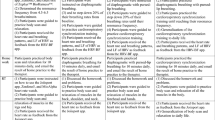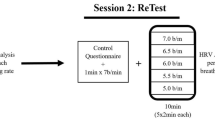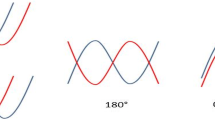Abstract
Heart rate and blood pressure, as well as other physiological systems, among healthy people, show a complex pattern of variability, characterized by multifrequency oscillations. There is evidence that these oscillations reflect the activity of homeostatic reflexes. Biofeedback training to increase the amplitude of respiratory sinus arrhythmia (RSA) maximally increases the amplitude of heart rate oscillations only at approximately 0.1 Hz. To perform this task people slow their breathing to this rate to a point where resonance occurs between respiratory-induced oscillations (RSA) and oscillations that naturally occur at this rate, probably triggered in part by baroreflex activity. We hypothesize that this type of biofeedback exercises the baroreflexes, and renders them more efficient. A manual is presented for carrying out this method. Supporting data are provided in Lehrer, Smetankin, and Potapova (2000) in this issue.
Similar content being viewed by others
REFERENCES
Asmundson, G. J. G., & Stein, M. B. (1994). Vagal attenuation in panic disorder: An assessment of parasympathetic nervous system function and subjective reactivity to respiratory manipulations. Psychosomatic Medicine, 56, 187–193.
Bai, C. X. (1991). Application of pursed lips breathing to chronic obstructive pulmonary disease patients with respiratory insufficiency. Chinese Journal of Tuberculosis and Respiratory Disease, 14, 283–284.
Bernardi, L., Leuzzi, S., Radaelli, A., Passino, C., Johnston, J. A., & Sleight, P. (1994). Low frequency spontaneous fluctuations of R-R interval and blood pressure in conscious humans: A baroreceptor or central phenomenon? Clinical Science, 87, 647–654.
Berntson, G. G., Bigger, J. T., Jr., Eckberg, D. L., Grossman, P., Kaufmann, P. G., Malik, M., Nagaraja, H. N., Porges, S. W., Saul, J. P., Stone, P. H., & van der Molen, M. W. (1997). Heart rate variability: Origins, methods, and interpretive caveats. Psychophysiology, 34, 623–648.
Binder, T., Frey, B., Porenta, G., Heinz, G., Wutte, M., Kreiner, G., Grossinger, H., Schmidinger, H., Pacher, R., & Weber, H. (1992). Prognostic value of heart rate variability in patients awaiting cardiac transplantation. Pacing and Clinical Electrophysiology, 15, 2215–2220.
Chernigovskaya, N. V., Vaschillo, E. G., Rusanovsky, B. B., & Kashkarova, O. E. (1990). Instrumental autotraining of mechanisms for cardiovascular function regulation in treatment of neurotics [Russian]. The SS Korsakov's Journal of Neuropathology and Psychiatry, 90, 24–28.
De Meersman, R. E. (1993). Aging as a modulator of respiratory sinus arrhythmia. Journal of Gerontology, 48, B74.
Giardino, N. D., Lehrer, P. M., & Feldman, J. M. (2000). The Role of Oscillations in Self-Regulation: A Revision of the Classical Model of Homeostasis. In D. Kenny, J. G. Carlson, F. J. McGuigan, & J. L. Sheppard (Eds). Stress and health: Research and clinical applications (pp. 27–52). Amsterdam: Harwood.
Goldberger, A. L. (1991). Is the normal heartbeat chaotic or homeostatic? News in Physiological Science, 6, 87–91.
Hyundman, B. W. (1973). The role of rhythms in homeostasis. Kybernetic, 15, 227–236.
Kleiger, R. E., Miller, J. P., Bigger, J. T., & Moss, A. J. (1987). Decreased heart rate variability and its association with increased mortality after acute myocardial infarction. American Journal of Cardiology, 59, 256–262.
Laitinen, T., Hartikainen, J., Niskanen, L., Geelen, G., & Länsimies, E. (1999). Sympathovagal balance is a major determinant of short-term blood pressure variability in healthy subjects. American Journal of Physiology, 276, H1245.
Lehrer, P. M., Carr, R. E., Smetankine, A., Vaschillo, E., Peper, E., Porges, S., Edelberg, R., Hamer, R., & Hochron, S. (1997). Respiratory sinus arrhythmia versus neck/trapezius EMG and incentive inspirometry biofeedback for asthma: A pilot study. Applied Psychophysiology and Biofeedback, 22, 95–109.
Lehrer, P., Smetankin, A., & Potapova, T. (2000). Respiratory sinus arrhythmia biofeedback therapy for asthma: A report of 20 unmedicated pediatric cases using the Smetankin method. Applied Psychophysiology and Biofeedback, this issue.
Lehrer, P. M., Sasaki, Y., & Saito, Y. (1999). Zazen and cardiac variability. Psychosomatic Medicine, 61, 812–821.
Mancia, G., Giannattasio, C., Turrini, D., Grassi, G., & Omboni, S. (1995). Structural cardiovascular alterations and blood pressure variability in human hypertension. Journal of Hypertension—Supplement, 13, S7–S14.
Peng, C. K., Buldyrev, S. V., Hausdorff, J. M., Havlin, S., Mietus, J. E., Simons, M., Stanley, H. E., & Goldberger, A. L. (1996). Non-equilibrium dynamics as an indispensable characteristic of a healthy biological system. Integrative Physiological and Behavioral Science, 29, 283–293.
Pitzalis, M. V., Passantino, A., Massari, F., Forleo, C., Balducci, C., Santoro, G., Mastropasqua, F., Antonelli, G., & Rizzon, P. (1999). Diastolic dysfunction and baroreflex sensitivity in hypertension. Hypertension, 33, 1141–1145.
Porges, S. W. (1986). Respiratory sinus arrhythmia: Physiological basis, quantitative methods, and clinical implications. In Grossman, P., Janssen, K., & Vaitl, D. (Eds.), Cardiorespiratory and Cardiosomatic Psychophysiology (pp. 101–115). New York: Plenum Press.
Porges, S. W. (1995). Orienting in a defensive world: Mammalian modifications of our evolutionary heritage. A Polyvagal Theory. Psychophysiology, 32, 301–318.
Rich, M. W., Saini, J. S., Kleiger, R. E., Carney, R. M., te Velde, A., & Freeland, K. E. (1988). Correlation of heart rate variability with clinical and angiographic variables and late mortality after coronary angiography. American Journal of Cardiology, 62, 714–717.
Rosenbaum, D. S., Jackson, L. E., Smith, J. M., Garan, H., Ruskin, J. N., & Cohen, R. J. (1994). Electrical alterans and vulnerability to ventricular arrhythmia. New England Journal of Medicine, 330, 235–241.
Taylor, J. A., & Eckberg, D. L. (1996). Fundamental relations between short-term RR interval and arterial pressure oscillations in humans. Circulation, 93, 1527–1532.
Vaschillo, E. G. (1984). Dynamics of slow-wave cardiac rhythm structure as an index of the functional state of an operant. Unpublished Ph.D. dissertation, Leningrad State University, Russia.
Vaschillo, E., Lehrer, P., Rishe, N., & Konstantinov, M. (Submitted for publication). Voluntary control of slow-wave heart rhythm structure: Frequency analysis of the cardiovascular system.
Vein, A. M, Oknin, V. I., Khaspekova, N. B., & Fedotova, A. V. (1998). State of autonomic regulation mechanisms in arterial hypotension. [Russian] Zhurnal Nevrologii i Psikhiatrii Imeni S. S. Korsakova, 98, 20–24.
Zingerman, A. M., Nikitina, S. B., & Nikiforova, O. V. (1994). Alternative biocontrol as a psychophysiological mechanism of functional adaptive self-regulation. Physiology Journal named after IM Sechenov, 80, 4–49.
Author information
Authors and Affiliations
Rights and permissions
About this article
Cite this article
Lehrer, P.M., Vaschillo, E. & Vaschillo, B. Resonant Frequency Biofeedback Training to Increase Cardiac Variability: Rationale and Manual for Training. Appl Psychophysiol Biofeedback 25, 177–191 (2000). https://doi.org/10.1023/A:1009554825745
Issue Date:
DOI: https://doi.org/10.1023/A:1009554825745




